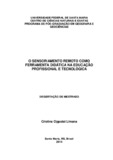| dc.creator | Limana, Cristina Cippolat | |
| dc.date.accessioned | 2015-04-06 | |
| dc.date.available | 2015-04-06 | |
| dc.date.issued | 2014-09-26 | |
| dc.identifier.citation | LIMANA, Cristina Cippolat. THE REMOTE SENSING AS A TOOL IN TEACHING PROFESSIONAL EDUCATION AND TECHNOLOGICAL. 2014. 74 f. Dissertação (Mestrado em Geociências) - Universidade Federal de Santa Maria, Santa Maria, 2014. | por |
| dc.identifier.uri | http://repositorio.ufsm.br/handle/1/9423 | |
| dc.description.abstract | This study addresses the integration and use of technology in professional and technological education level, with emphasis on remote sensing tools. The overall objective of the research was to conduct a diagnosis of the use of Remote Sensing technology, technical education, with technical courses in Agriculture, Information Technology, Sales, Agribusiness and Administration courses offered by these Instituto Federal Farroupilha Campus Jaguari RS. Methodologically the study started with literature search to identify work already developed on Remote Sensing in Vocational and Technical Education; after the field research and the audience were chosen, we applied a questionnaire consisting of two parts, the first part in order to identify and the second theoretical part, with questions specific knowledge about Remote Sensing. The next step was to organize the data collected, confection tables and graphs. From these data, we proceeded to an argumentative analysis. Some of the results showed that most students is the Course Technical Administration, women and residing in the municipality of Jaguari, approximately half of the sample said to have never heard of Remote Sensing, but claim to have interest in this subject and believe that the Remote Sensing may be linked in some way with your technical course, thus highlighting the importance of working together students and teachers, aimed at working concepts and theories about the Remote Sensing and that makes sense to the reality of each course. | eng |
| dc.description.sponsorship | Coordenação de Aperfeiçoamento de Pessoal de Nível Superior | |
| dc.format | application/pdf | por |
| dc.language | por | por |
| dc.publisher | Universidade Federal de Santa Maria | por |
| dc.rights | Acesso Aberto | por |
| dc.subject | Ensino técnico | por |
| dc.subject | Sensoriamento remoto | por |
| dc.subject | Educação | por |
| dc.subject | Technical education | eng |
| dc.subject | Remote sensing | eng |
| dc.subject | Education | eng |
| dc.title | O sensoriamento remoto como ferramenta didática na educação profissional e tecnologica | por |
| dc.title.alternative | The remote sensing as a tool in teaching professional education and technological | eng |
| dc.type | Dissertação | por |
| dc.description.resumo | Este estudo trata da inserção e do uso das tecnologias na educação de nível profissional e tecnológico, com ênfase nas ferramentas do sensoriamento remoto. O objetivo geral da pesquisa foi realizar um diagnóstico sobre a utilização de tecnologias do Sensoriamento Remoto SR, no ensino técnico, junto aos cursos técnicos em Agricultura, Informática, Vendas, Agroindústria e Administração, cursos esses ofertados pelo Instituto Federal Farroupilha Campus Jaguari, RS. Metodologicamente, o estudo iniciou com pesquisa bibliográfica para identificar trabalhos já desenvolvidos sobre SR na educação Profissional e Tecnológica; após foram escolhidos o campo de pesquisa e o público-alvo. Depois disso, aplicou-se um questionário composto por duas partes, a primeira parte com a finalidade de identificar e a segunda parte teórica, com perguntas de conhecimentos específicos sobre SR. A etapa seguinte foi a de organizar os dados coletados e confeccionar tabelas e gráficos. A partir desses dados, procedeu-se uma análise argumentativa. Alguns dos resultados obtidos revelaram que a maioria dos alunos é do Curso Técnico em Administração, do sexo feminino e que residem no município de Jaguari. Aproximadamente metade da amostra diz nunca ter ouvido falar em SR, mas afirmam ter interesse nesse assunto e acreditam que o SR possa estar ligado de alguma forma com o seu curso técnico, ressaltando assim, a importância de um trabalho em conjunto com os alunos e professores, que vise abordar os conceitos e teorias sobre o SR conforme a realidade de cada curso. | por |
| dc.contributor.advisor1 | Pires, Carlos Alberto da Fonseca | |
| dc.contributor.advisor1Lattes | http://buscatextual.cnpq.br/buscatextual/visualizacv.do?id=K4785607T0 | por |
| dc.contributor.referee1 | Becker, Elsbeth Léia Spode | |
| dc.contributor.referee1Lattes | http://buscatextual.cnpq.br/buscatextual/visualizacv.do?id=K4763810D2 | por |
| dc.contributor.referee2 | Bolfe, Sandra Ana | |
| dc.contributor.referee2Lattes | http://buscatextual.cnpq.br/buscatextual/visualizacv.do?id=K4721626Y6 | por |
| dc.creator.Lattes | http://lattes.cnpq.br/3013265170227281 | por |
| dc.publisher.country | BR | por |
| dc.publisher.department | Geografia | por |
| dc.publisher.initials | UFSM | por |
| dc.publisher.program | Programa de Pós-Graduação em Geografia | por |
| dc.subject.cnpq | CNPQ::CIENCIAS HUMANAS::GEOGRAFIA | por |


